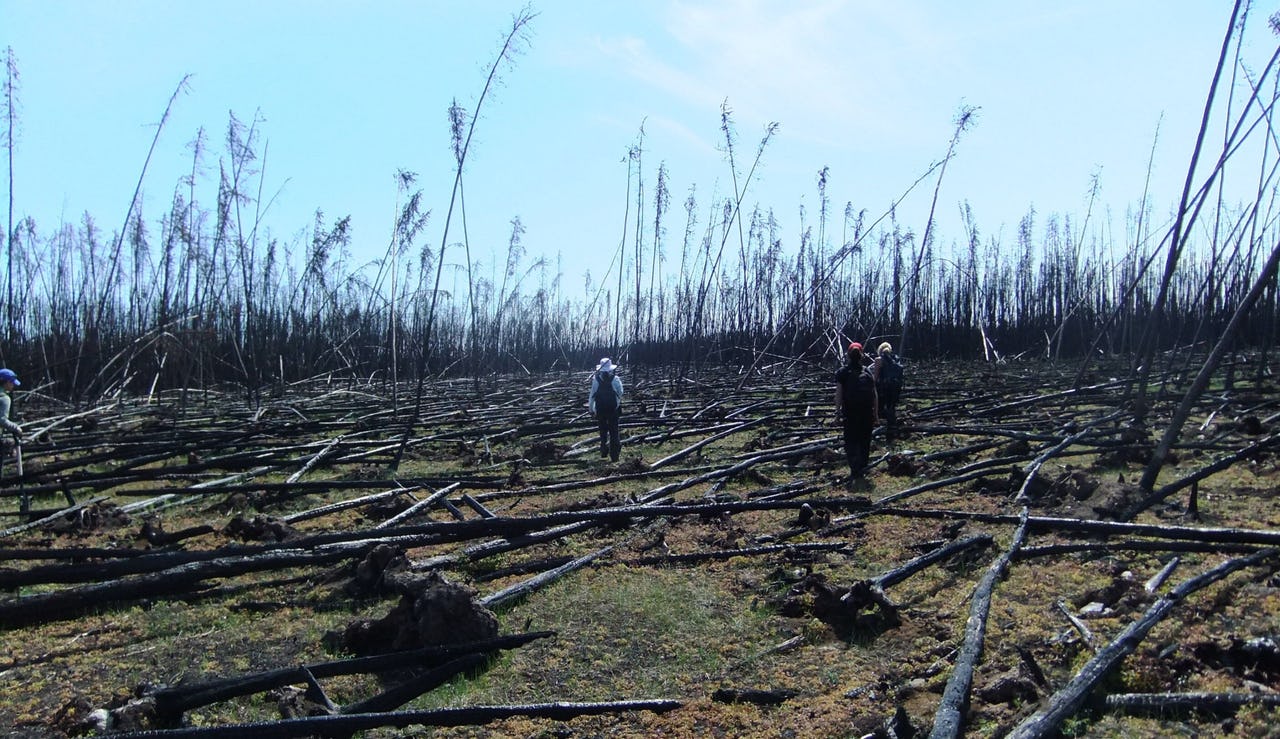Wildfires – The Arctic Amplification Feedback Cycle

Researchers measuring and evaluating the presence of “legacy carbon” after the 2014 fires in Canada’s Northwest Territories. Photo: Xanthe Walker (NASA)
As spring transitions into summer, and summer transitions into fall, unprecedented wildfires are devastating large land areas within the Arctic Circle. These wildfires have reached a greater extent and intensity than has been recorded in previous years, reaching parts of Alaska, Siberia, Greenland, and Canada. The wildfires are thought to be caused by lightning strikes, which ignite relatively dry, warm ground, and spread rapidly due to strong winds. These conditions are cause for concern, especially when we consider the likelihood for the increased prevalence of these conditions as a product of climate change.
While climate change is increasing the ground temperature in Arctic regions and contributing to the frequency of wildfires, the damage caused by wildfires may in turn cause compounding effects that will continue to drive climate change. As Arctic forests and soils succumb to wildfires, the carbon sequestered within them is released into the atmosphere, contributing to increased atmospheric carbon and an increased greenhouse effect. Additionally, if trees are killed or altered due to a wildfire event, photosynthetic activity may decrease. This change in plant life may hinder the carbon sequestering capability of the land for years following a fire event, leading to less atmospheric carbon being absorbed into the land. High concentrations of carbon in the atmosphere are known to trap heat and be a strong driver of climate change, which will only contribute to further wildfires.
Soil Impacts
When land is overtaken by a wildfire, organic carbon in the soil is combusted and large amounts of carbon are released into the atmosphere. Layers of soil beneath the burned surface layer, termed “legacy carbon,” are important for maintaining sequestered carbon. Deep carbon stores are considered one of the most important carbon sinks, holding around 600 megatons of carbon. If wildfires increase in extent and intensity, the burned soil may reach greater depths. This occurrence is expected to reduce the amount of legacy carbon maintained, and drastically increase the soil organic carbon combusted and released during a fire event.
In regard to storage and combustion of legacy carbon, or deep soil carbon, soil moisture and stand age (age of the tree community) are key influencing factors. Soil moisture increases the amount of legacy carbon stored and decreases the likelihood of combustion by wildfire, as the deep soil layer has reactive minerals, which bind to, protect, and stabilize the stored carbon. Younger stands are more likely to lead to a release of legacy carbon, as compared to older stands. As stands are threatened and destroyed by wildfires, younger stands may become more prevalent than older stands. As climate change continues to impact the Arctic, soil moisture is expected to decrease, leading to drier soils. These factors may continue to threaten legacy carbon concentration and drastically increase the combustion of organic soil carbon following a fire event.
Tree Impacts
As trees are exposed to high temperatures during a wildfire event, plant material is burned, releasing carbon into the atmosphere. With higher temperatures and greater fire extent, there is a higher chance of tree mortality. Trees, and other plants, are of monumental importance when considering terrestrial carbon sequestration. Trees perform photosynthesis during which they absorb carbon dioxide from the atmosphere, release oxygen into the atmosphere, and store carbon in biomass and soil. If trees are damaged or killed in a wildfire event, it is estimated that carbon sequestration rates could be negatively impacted for several years to follow.
Ongoing studies are seeking to determine the factors that lead to tree mortality, but there are obvious differences between tree species. When exposed to wildfire, certain trees have been known to alter their structure and size in response. If the trees within these wildfire-exposed Arctic regions decrease in size or foliage, the amount of carbon sequestered through photosynthesis would noticeably decrease.
Wildfire Threats
The Arctic is experiencing an amplified climate warming phenomenon when compared to the rest of the world. Global temperatures are steadily rising, and Arctic temperatures are rising at an especially increased rate. The current and expected future conditions seem to be moving toward wildfire-prone circumstances: dry, hot, and windy. If the current trajectory continues, Arctic wildfires may become more extensive and frequent in years to come.
Wildfires are fearsome events, capable of vast amounts of destruction. It is easy to see the immediate destruction that a wildfire brings to lands and habitats, but it is more difficult to see the lasting impact that a wildfire brings to the climate. There is still more to be understood about Arctic wildfires, but it is evident that there are wide and lasting consequences. Given these effects and the likelihood of future wildfire events, it is crucial to study the reduction and mitigation of wildfires in a climate change scenario. Ultimately, the carbon released from Arctic wildfires impacts the entire world, as Arctic amplification leads to a feedback cycle that furthers global climate change.
Alyssa Burns is a PhD Student in Agricultural and Environmental Chemistry at University of California – Davis.